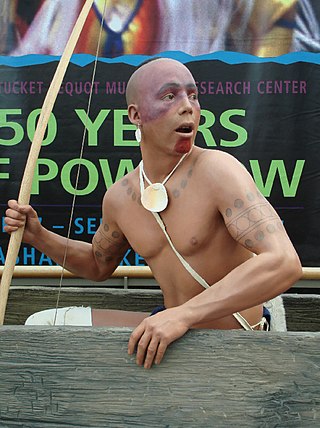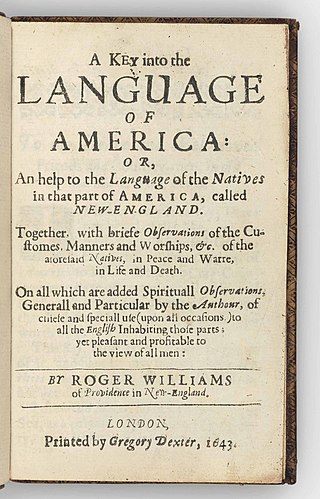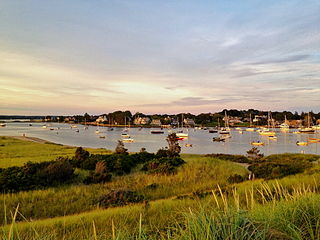Related Research Articles

Roger Williams was an English-born New England Puritan minister, theologian, and author who founded Providence Plantations, which became the Colony of Rhode Island and Providence Plantations and later the State of Rhode Island. He was a staunch advocate for religious freedom, separation of church and state, and fair dealings with the Native Americans.

The Pequot are a Native American people of Connecticut. The modern Pequot are members of the federally recognized Mashantucket Pequot Tribe, four other state-recognized groups in Connecticut including the Eastern Pequot Tribal Nation, or the Brothertown Indians of Wisconsin. They historically spoke Pequot, a dialect of the Mohegan-Pequot language, which became extinct by the early 20th century. Some tribal members are undertaking revival efforts.

Old Saybrook is a town in Middlesex County, Connecticut, United States. The town is part of the Lower Connecticut River Valley Planning Region. The population was 10,481 at the 2020 census. It contains the incorporated borough of Fenwick, and the census-designated places of Old Saybrook Center and Saybrook Manor.

The Pequot War was an armed conflict that took place in 1636 and ended in 1638 in New England, between the Pequot tribe and an alliance of the colonists from the Massachusetts Bay, Plymouth, and Saybrook colonies and their allies from the Narragansett and Mohegan tribes. The war concluded with the decisive defeat of the Pequot. At the end, about 700 Pequots had been killed or taken into captivity. Hundreds of prisoners were sold into slavery to colonists in Bermuda or the West Indies; other survivors were dispersed as captives to the victorious tribes.

The Connecticut Colony or Colony of Connecticut, originally known as the Connecticut River Colony or simply the River Colony, was an English colony in New England which later became Connecticut. It was organized on March 3, 1636 as a settlement for a Puritan congregation, and the English permanently gained control of the region in 1637 after struggles with the Dutch. The colony was later the scene of a bloody war between the colonists and Pequots known as the Pequot War. Connecticut Colony played a significant role in the establishment of self-government in the New World with its refusal to surrender local authority to the Dominion of New England, an event known as the Charter Oak incident which occurred at Jeremy Adams' inn and tavern.

The Niantic are a tribe of Algonquian-speaking American Indians who lived in the area of Connecticut and Rhode Island during the early colonial period. They were divided into eastern and western groups due to intrusions by the more numerous and powerful Pequots. The Western Niantics were subject to the Pequots and lived just east of the mouth of the Connecticut River, while the Eastern Niantics became very close allies to the Narragansetts. It is likely that the name Nantucket is derived from the tribe's endonym, Nehantucket.

Roger Ludlow (1590–1664) was an English lawyer, magistrate, military officer, and colonist. He was active in the founding of the Colony of Connecticut, and helped draft laws for it and the nearby Massachusetts Bay Colony. Under his and John Mason's direction, Boston's first fortification, later known as Castle William and then Fort Independence was built on Castle Island in Boston harbor. Frequently at odds with his peers, he eventually also founded Fairfield and Norwalk before leaving New England entirely.

John Winthrop the Younger was an early governor of the Connecticut Colony, and he played a large role in the merger of several separate settlements into the unified colony.

John Mason was an English-born settler, soldier, commander and Deputy Governor of the Connecticut Colony. Mason was best known for leading a group of Puritan settlers and Indian allies on a combined attack on a Pequot Fort in an event known as the Mystic Massacre. The destruction and loss of life he oversaw effectively ended the hegemony of the Pequot tribe in southeast Connecticut.

The Saybrook Colony was an English colony established in New England in late 1635 at the mouth of the Connecticut River which today is Old Saybrook, Connecticut. Saybrook was founded by John Winthrop the Younger, son of John Winthrop the Governor of the Massachusetts Bay Colony. Winthrop the Younger was designated Governor by the original settlers, including Colonel George Fenwick and Captain Lion Gardiner. They claimed possession of the land via a deed of conveyance from Robert Rich, 2nd Earl of Warwick. The colony was named in honor of Lords Saye and Brooke, prominent Parliamentarians and holders of the colony's land grants.

Ninigret was a sachem of the eastern Niantic Indian tribe in New England at the time of colonization, based in Rhode Island. In 1637, he allied with the colonists and the Narragansetts against the Pequot Indians.
Wyandanch (c. 1571 – 1659 was a sachem of the Montaukett Indians in the mid-17th century on eastern Long Island. Initially he was a minor chief among the Montaukett, but due to his skillful manipulation of various alliances and his accommodating stance towards the European colonists who gave him substantial military and economic support, he eventually became an influential "alliance chief" (a sachem who was responsible for maintaining friendly relations between his tribe and the settlers).

The Mystic massacre – also known as the Pequot massacre and the Battle of Mystic Fort – took place on May 26, 1637 during the Pequot War, when a force from the Connecticut Colony under Captain John Mason and their Narragansett and Mohegan allies set fire to the Pequot Fort near the Mystic River. They shot anyone who tried to escape the wooden palisade fortress and killed most of the village. There were between 400 and 700 Pequots killed during the attack; the only Pequot survivors were warriors who were away in a raiding party with their sachem Sassacus.

Simon Willard (1605–1676) was an early Massachusetts fur trader, colonial militia leader, legislator, and judge.

A Key into the Language of America or An help to the Language of the Natives in that part of America called New England is a book written by Roger Williams in 1643 describing the Native American languages in New England in the 17th century, largely Narragansett, an Algonquian language. The book is the first published colonial study of a Native American language in English.
George Fenwick (1603?–1657), was an English Parliamentarian, and a leading colonist in the short-lived Saybrook Colony.

Harman Garrett was a Niantic sachem and then governor of the Eastern Pequots slightly east of the Pawcatuck River in what is now Westerly, Rhode Island. His chosen English name was very similar to that of Herman Garrett, a prominent colonial gunsmith from Massachusetts in the 1650s.
The Atherton Trading Company also known as the Atherton Syndicate was formed in 1659; with Humphrey Atherton and John Winthrop, Governor of Connecticut at the helm. This partnership of merchants and investors included Simon Bradstreet, Daniel Denison, Elisha Hutchinson, Richard Smith and Boston traders; John Tinker, Amos Richardson and William Hudson. Edward Hutchinson joined and by 1661, Plymouth investors included Josiah Winslow, John Brown and Thomas Willet. Their land speculation in the Narragansett area of Rhode Island was at the expense of the Native American inhabitants.
Wepitanock was an Eastern Niantic chief sachem in the area around Rhode Island and Connecticut.
References
- Citations
- ↑ New England's First Fruits , London, Printed by R. O. and G.D. for Henry Overton, 1643 (republished 1865) (Google Books)
- ↑ Shawn G. Wiemann, Lasting Marks: The Legacy of Robin Cassacinamon and the Survival of the Mashantucket Pequot Nation (University of New Mexico, Dissertation, 2011), p. 119 http://digitalrepository.unm.edu/cgi/viewcontent.cgi?article=1082&context=hist_etds
- ↑ The history of Guilford, Connecticut, from its first settlement in 1639 By Ralph Dunning Smith (J. Munsell, printer, 1877), pg 69
- ↑ Edward Elias Atwater; Lucy M. Hewitt; Bessie E. Beach (1902). History of the Colony of New Haven to Its Absorption Into Connecticut. Journal Publishing Company.
- ↑ John Winthrop, James Kendall Hosmer, Winthrop's journal, "History of New England", 1630-1649, Volume 2, Original narratives of early American history, (1642), pg. 69
- ↑ Jim Trocchi (2011). "Acculturation of Native Americans in Southern New England". FOSA Newsletter Reprints. Retrieved 2013-02-27.
- ↑ The History of Guilford, Connecticut, p. 69 (footnote)https://www.cga.ct.gov/hco/books/The_History_of_Guilford.pdf
- ↑ History of the Indians of Connecticut from the earliest known period to 1850 By John William De Forest, Felix Octavius Carr Darley, (W. J. Hamersley, 1851) pg. 181
- ↑ Katherine Dimancescu, Denizens: A Narrative of Captain George Denison and His New England ... (2018), p. 124 https://books.google.com/books?isbn=0989616983
- ↑ Katherine Dimancescu, Denizens: A Narrative of Captain George Denison and His New England ... (2018), p. 124 https://books.google.com/books?isbn=0989616983
- Sources
- Richard A. Wheeler (1870). The Pequot Indians, an historical sketch. Westerley, R.I.: G.B. & J.H. Utter, Steam printers. pp. 9–13. Retrieved 2013-02-27.